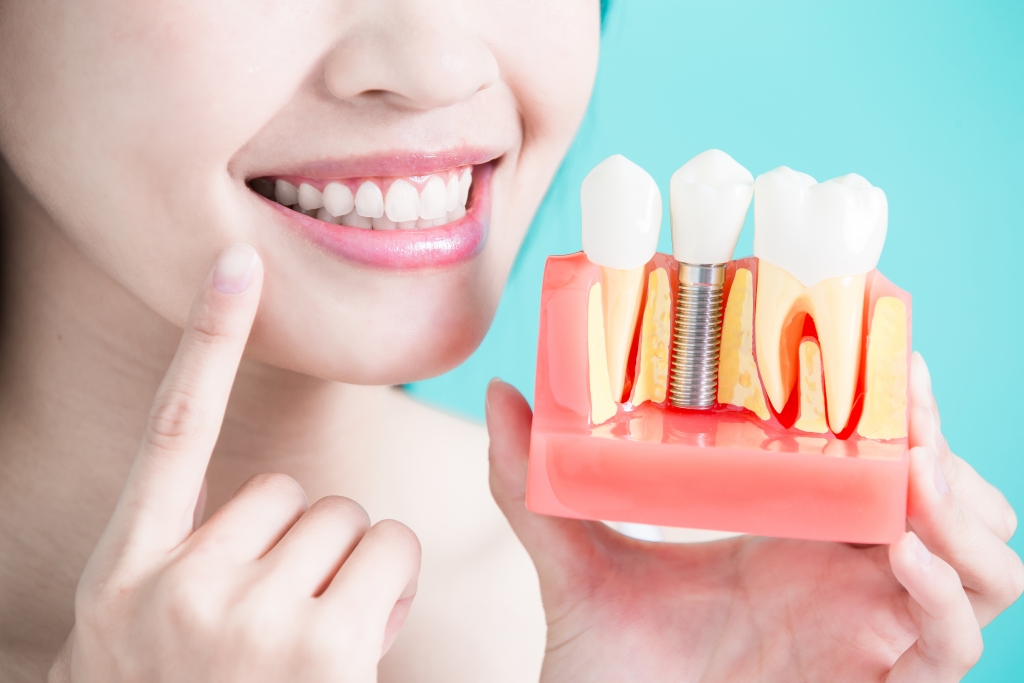Dental Implants
A dental implant is a specialized procedure performed by a specialist called a prosthodontist who is highly trained to restore or replace teeth with implants, dentures or bridges. An implant is a synthetic tooth that is screwed into the jawbone as a permanent replacement for a lost or removed tooth. Patients who require more than one implant will have work done on several teeth at the same time.
For more substantial tooth loss, patients can consider dentures, All-on-4 or All-on-6 implant options. Your dental professional will review the options with you to help you select the treatment that is best for you.
Benefits of Dental Implants
Dental implants have many benefits
- To replace missing teeth
- An alternative to bridges or dentures
- A variety of treatments depending on your needs
- All-on-4 or All-on-6 options
- Improved self-esteem and an increased quality of life
- The solid anchorage of the implant allows increased chewing pressure, in other words eat anything you want
- Improves speech as compared to having dentures
- Improved comfort relative to removable dentures
- Prevents further loss of teeth and bone support
- An improved natural appearance
- Improvement of your oral health
- Dental implants are very durable
Depending on your particular dental needs and the provider you choose, a prosthodontist may complete the treatment in one visit however your situation could require more than one visit over a period of time.
Types of Dental Implants
The main types of implants.
- Conventional implants – used to replace one or multiple missing teeth with a permanent solution and normally done in 2 trips between 2 to 6 months apart. These may be done for most types of bone conditions however any moderate or severe jaw bone loss, may require bone grafting prior to dental implantation.
- Immediate implants (one day or same day implants) – these are placed during the same visit that teeth are extracted and are normally recommended only for cases with good jaw bone conditions.
- Immediate loaded implants – permanent or temporary crowns, bridges or dentures are placed during the same trip when the implant posts are embedded in jaws and are normally recommended only for cases with good jawbone conditions
The type of dental implants will depend on your specific needs and general dental condition. A panoramic x-ray and/or CT scan is usually required to evaluate the amount of bone and available space because a thorough examination will provide the best diagnosis and options available.
Dental implants Restoration Types
The single tooth implant restoration consists of three parts. The implant post which replaces the tooth root, the abutment which will support the crown and the prosthetic crown itself. The crown is cemented onto the abutment or held in place with a screw. A single tooth implant with crown is one of the best permanent restorations because it looks and functions just like a natural tooth
Multiple teeth missing in different parts of the mouth uses several single tooth implants, however if multiple teeth are missing in the same region, these be replaced with having implant fixed bridges
All teeth missing or in poor condition, there are two basic types of full arch implant reconstruction options:
- Fixed Bridges anchored to dental implants. It’s possible to replace a full jaw with dental implants and a fixed bridge resulting in a permanent, stable and high esthetic solution similar to having a new set of teeth.
- Implant Supported Dentures allow you to wear full dentures (overdentures) and partial dentures without worrying that they will slip or fall out. For overdentures, implants with screws placed in the jaw will serve as attachments for a metal bar to support a removable denture.
What happens during the implant procedure?
Firstly a local anesthesia is applied so that you do not feel pain and are awake during the treatment. Secondly the prosthodontist drills a small hole into the jaw bone where the missing tooth was. A special implant screw is inserted into the jaw bone and covered with gum, therefore allowing the screw to settle in the mouth and fix to the jawbone. A temporary crown may be fitted over the implant to protect the screw because it needs to heal for two to six months.
For most people, a second visit to the prosthodontist is needed. The temporary crown is removed and a permanent crown is fitted over the implant and cemented in place. The replacement tooth or teeth are fixed in place and are not removable like dentures or bridges.
Recovery Expectations
Following placement of the implants in the jaw, the bone may be sore and the surrounding gums tender and swollen, however patients are able to go about their normal daily activities a day after surgery avoiding any rigorous physical activities.
Care for Dental implants
Dental implants require the same care as real teeth, including brushing, flossing, and regular dental check-ups:
- Brush after eating and before bedtime around the implant using a soft toothbrush
- Floss at least once to twice a day
- Rinse with fluoride rinse before bed. Swish the fluoride rinse vigorously in your mouth for about one minute. Do not swallow the rinse and do not eat or drink anything for 30 minutes
- Be careful chewing toffees, gum, grainy rolls and tough food in the area
- See your dentist for regular professional check-ups and cleanings
Take the next step with us
Need more information? Or ready to take the next step? Click on one of the icons to request a FirmQuote! Get started today!
How Long Does it Take to Get Dental Implants?
The length of time it takes to get dental implants can vary depending on the specific case and the type of implant being used. The process generally involves several stages, including:
- Initial consultation and planning: This step includes a thorough examination of the patient’s oral health, as well as a discussion of the patient’s goals and expectations.
- Preparation of the jawbone: If the patient does not have enough healthy bone to support the implant, a bone graft or sinus lift may be required. This step can take several months to heal.
- Placement of the implant: The implant is surgically inserted into the jawbone. The healing time for this step can vary depending on the type of implant, but it typically takes between 3 and 6 months.
- Attaching the abutment and prosthetic tooth: After the implant has fully integrated with the jawbone, an abutment (small connector post) is placed on the implant. The prosthetic tooth is then attached to the abutment. This step typically takes 1-2 weeks.
In total, the process of getting dental implants can take several months to a year, depending on the individual case.


